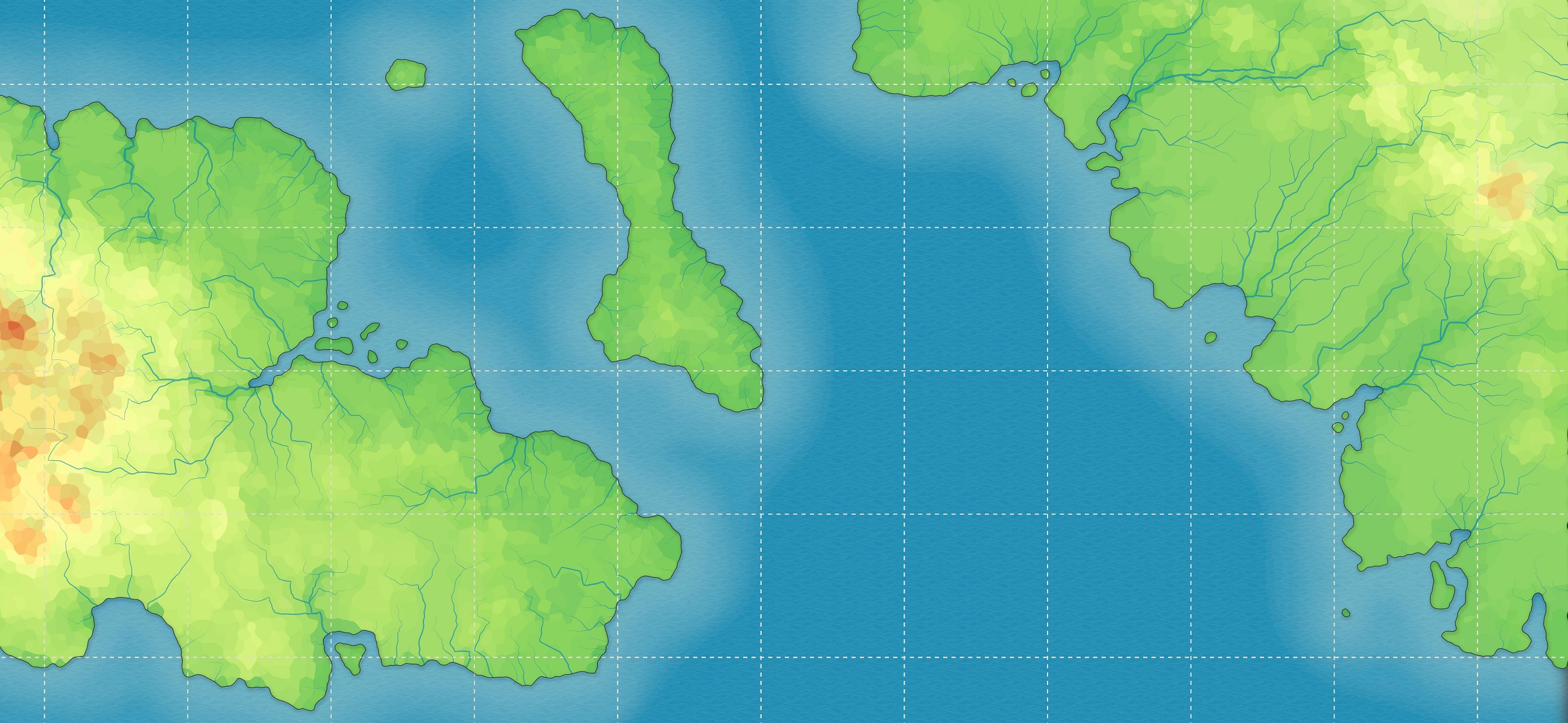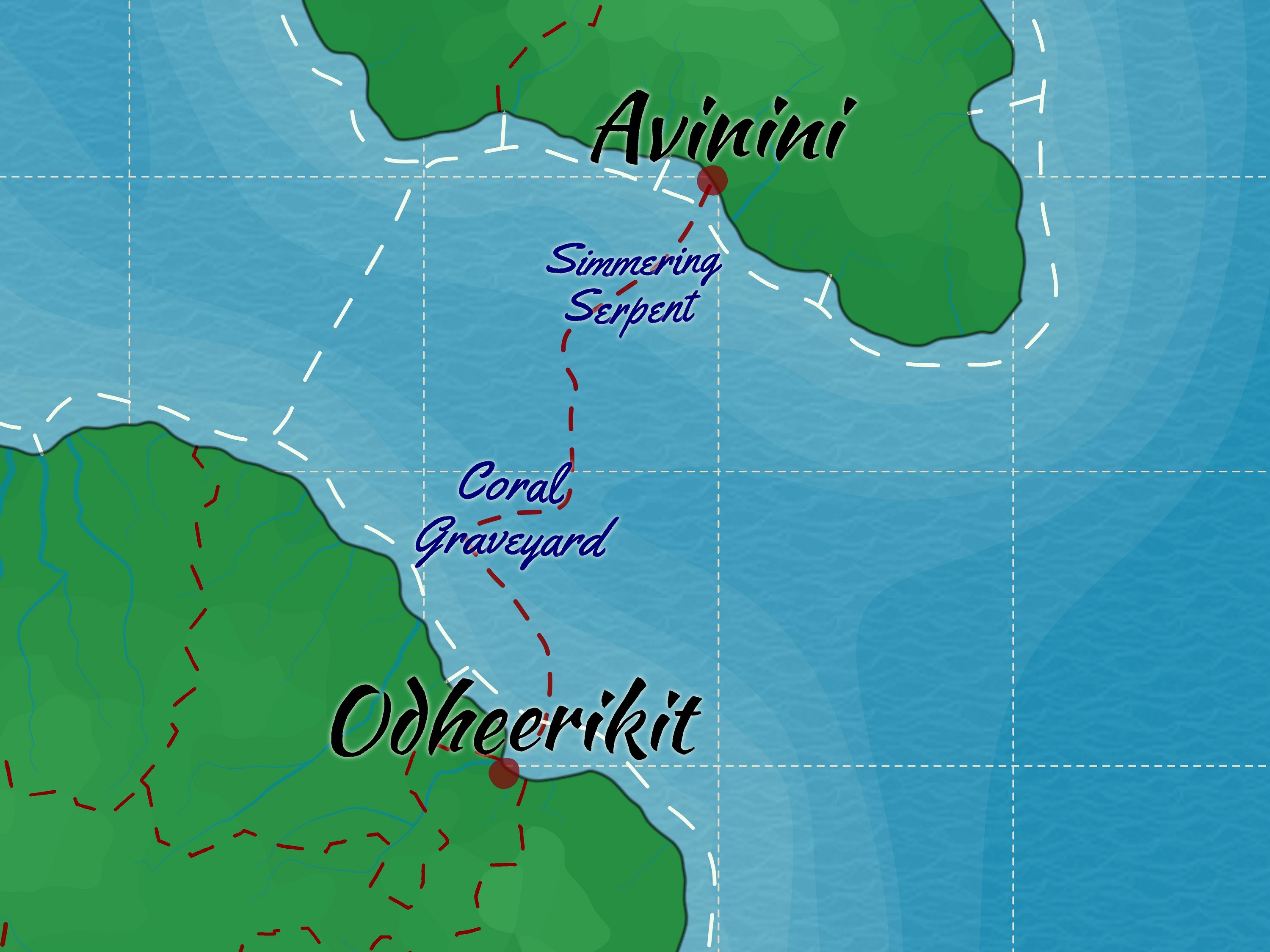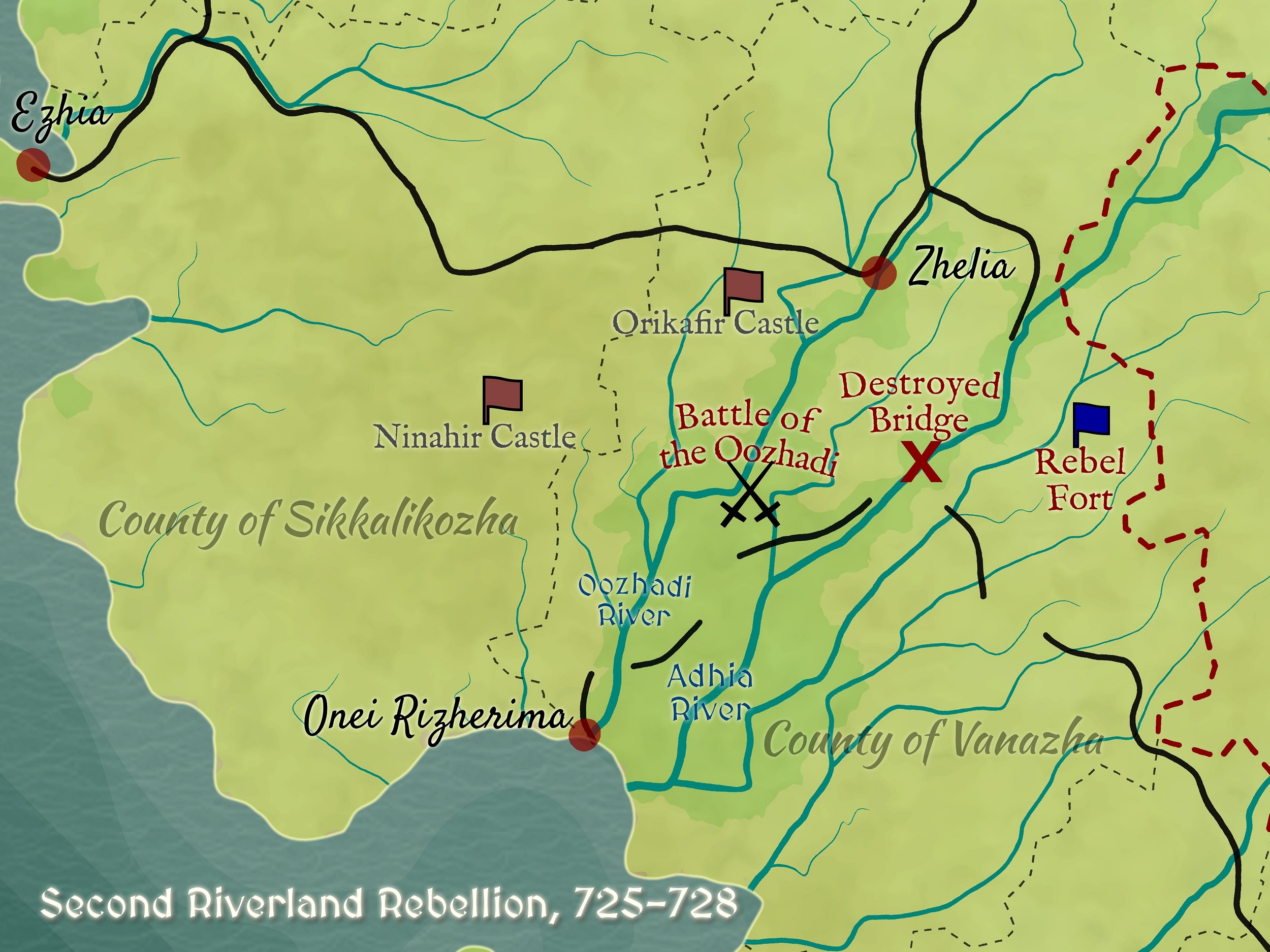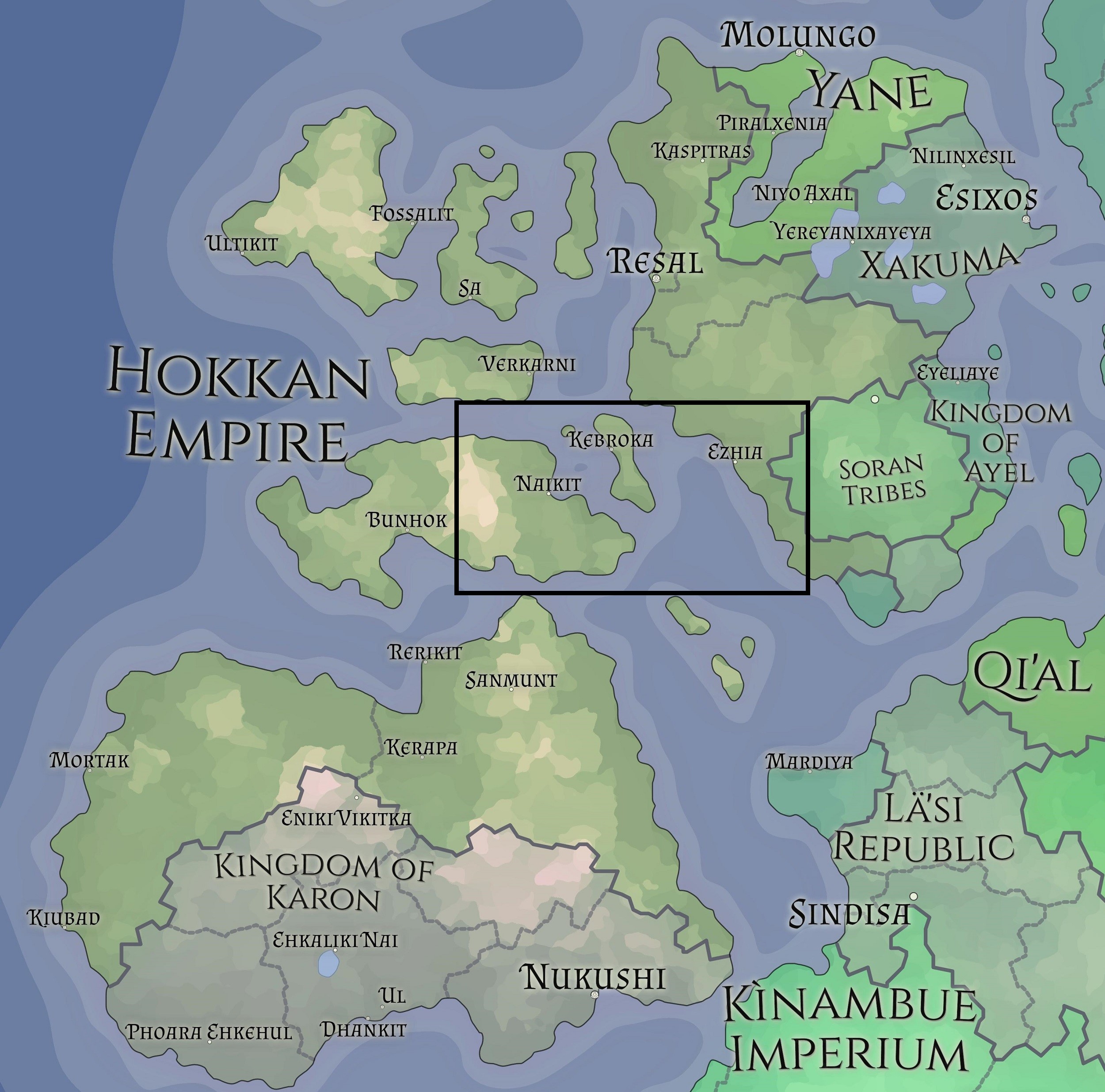The Venerable Coasts
The following are excerpts from Zhilo Serator's "Painting an Empire: A geographical history of Hokka in the 8th century", a definitive work on the imperial age under Kara II. Translated and annotated.
Overview
Introduction
The name "Venerable Coasts" can be traced back to the late 600s, when Kebroka residents started calling their home the "Venerable Island", possibly to make up for the recent loss of status. Over time this title started to encompass the nearby coasts of Rehia and South Ienazh. [...] Although this name suggests a unified cultural and economical centre, it was still very much divided into Hokkan and Ienan, Named and Unnamed, Spiritualist and Xomay, and coast and inland. [...] But despite all that, the Coasts, particularly Kebroka, were of great importance to Hokkan history and mythology, and was surprisingly often the stage of events that would shape the whole Empire, the Catastrophe of 800 included.The Venerable Coasts
For simplicity's sake I've defined the borders of the Venerable Coasts with Kebroka as their centerpiece and have further seperated them into four distinct parts:
The eastern half of the Province of Rehia, famous for its abundant metal resources and rich soil, making it invaluable to the economy and military of Hokka. In addition, the city of Naikit was the island's biggest port and often engaged in friendly competition (read: unsanctioned privateering) with Kebroka. All this was often overshadowed by [...] the looming threat of an eruption in the Black Peaks, a fear that would prove to be justified in 798: The Livid Maw spewed so much fire and ash into the sky that reports from places as distant as Äninuebi mentioned "black snow sullying (their) lands". [...]
Then, as now, Kebroka Island was an important trade hub and kept growing, with the city eventually becoming the Empire's largest one, housing between 250.000 and 300.000 people. Being a district, as apposed to a province, the crown had a lot more power over the ruling nobility, whose responsibilities were rather limited. This unintentionally strenghtened the Unnamed, particulary the merchants who had grown rich off the thousands of ships that landed on the island's shores every day. [...]
The eastern half of the Province of Rehia, famous for its abundant metal resources and rich soil, making it invaluable to the economy and military of Hokka. In addition, the city of Naikit was the island's biggest port and often engaged in friendly competition (read: unsanctioned privateering) with Kebroka. All this was often overshadowed by [...] the looming threat of an eruption in the Black Peaks, a fear that would prove to be justified in 798: The Livid Maw spewed so much fire and ash into the sky that reports from places as distant as Äninuebi mentioned "black snow sullying (their) lands". [...]
Then, as now, Kebroka Island was an important trade hub and kept growing, with the city eventually becoming the Empire's largest one, housing between 250.000 and 300.000 people. Being a district, as apposed to a province, the crown had a lot more power over the ruling nobility, whose responsibilities were rather limited. This unintentionally strenghtened the Unnamed, particulary the merchants who had grown rich off the thousands of ships that landed on the island's shores every day. [...]
The Province of South Ienazh was the source of most conflicts in the region, as its inhabitants had not forgotten decades of Hokkan conquest and oppression. Its hard to traverse wetlands, thick forests and constantly changing rivers had made it difficult for the Hokkans to exert control over the province. During the beginning of the 8th century, no year passed by without a riot, revolt or another form of protest taking place somewhere in the province. [...] The ruling nobles reacted with more and more drastic measures [...], which were ultimately effective at stopping armed conflict - at the cost of permanently destroying any hope of peaceful relations between Hokkans and Ienans.
Lastly, I decided to include the territories belonging to the various Soran tribes in the east, despite them at no point being fully controlled by the Empire or considered part of the Coasts. [...] However, the constant push and pull of Hokkan mercenaries and settlers on one side and Soran raids and ambushes on the other, had a large enough impact on the region that not to include them would leave out a significant amount of its history and context. [...]
Lastly, I decided to include the territories belonging to the various Soran tribes in the east, despite them at no point being fully controlled by the Empire or considered part of the Coasts. [...] However, the constant push and pull of Hokkan mercenaries and settlers on one side and Soran raids and ambushes on the other, had a large enough impact on the region that not to include them would leave out a significant amount of its history and context. [...]
A few points of interest and their history
Kebroka
Origin of royalty and money
Although it had not been the capital for a long time now, Kebroka still was an important seat of royal power. For the Tandofirs, whose upstart ancestors originally were from Kebroka, it was the source of their might and legitimacy. In fact, during her reign Kara II spent more time in the Jagged Keep, her family's old castle in Nispit, than in Resal. [...]
Despite all this, Kebroka was a place where the nobility was being slowly replaced by a rapidly growing merchant class, who didn't shy away from unscrupulous methods to secure their new-found power. One especially ruthless example was Risa Hekunator, who by the 770s had managed to get more than half of Kebroka City's nobles to do her bidding through a mix of paid thugs, bribes and money lending. Interestingly, a passage in a letter to one of her assistants suggests that she had greater motivations than pure lust for money and power:
Despite all this, Kebroka was a place where the nobility was being slowly replaced by a rapidly growing merchant class, who didn't shy away from unscrupulous methods to secure their new-found power. One especially ruthless example was Risa Hekunator, who by the 770s had managed to get more than half of Kebroka City's nobles to do her bidding through a mix of paid thugs, bribes and money lending. Interestingly, a passage in a letter to one of her assistants suggests that she had greater motivations than pure lust for money and power:
I had to stop myself from laughing in his face when Karo Rikkihir told me yesterday that my practices "disgust" him. He only sits where he does because one of his ancestors five generations ago was better at slaughtering the innocent than his brothers and sisters.
Here he stumbles around, leading and failing a city because his mother did, and her father did, and his father before him... They're cornered animals and their jealousy is rightfully turning into fear. [illegible] was right when he said that we're only taking back the centuries that were stolen from us.Despite these mounting tensions that threatened the Empire's social structure, the Empress did not seem especially keen on disrupting the fastest growing economy in Hokka. She finally decided to take action in 785, with Hokkan military arresting, exiling and in some cases executing wealthy Unnamed who were suspicious of corruption. Risa, for her part, managed to escape with most of her wealth intact to the Lä'si Republic, where she would go on to found a privateering company that targeted Hokkan ships. [...] The Empire had managed to preserve the old order - at least for now.
The Serpent's Strait
Hallowed and profitable waters
Apart from being an essential trade chokepoint, [...] the Serpent's Strait was of course the final resting place of the Simmering Serpent. It became a popular pilgrimage location for rich nobles who regularly hindered sea traffic by anchoring their vessels in the shallow waters and swimming out into the sea to attempt to get a look at the body of their creator, whose remains still laid half-buried on the ocean floor near Avinini. Over the course of the century a small tourism industry had sprung up as savvy merchants began to offer passage across the strait with a guarantee to see both the Serpent and the Coral Graveyard. It got so bad that in 762 Kila Serator, a captain from Bunhok en route to Kebroka, wrote the following into her log:
this is now the3rd4th time this year that we lost precious time just because some empty-headed blackbloods practically jumped in front of the TURTLE'S bow - thinking of just holding our course the next time, but this'll probably be more trouble than it's worth - Aino knows, if they keep this up it'll be faster to [illegible] or to sail the other way around the island
Popular pilgrimage route across the strait
Frustraded seafarers and reckless nobles aside, the strait was first and foremost a place where the ship traffic between the two great ports of Naikit and Kebroka, and the entire south was bundled. Even without overeager pilgrims this lead to occasional collisions. But these collisions remained for the most part the only danger for the countless trading ships - while Hokka could not entirely quell the spread of piracy, Kara II had taken drastic measures to safeguard the trade routes since taking office, dedicating entire fleets to patrolling the Southern Sea. [...] This proved to be effective for most of the century.
Frustraded seafarers and reckless nobles aside, the strait was first and foremost a place where the ship traffic between the two great ports of Naikit and Kebroka, and the entire south was bundled. Even without overeager pilgrims this lead to occasional collisions. But these collisions remained for the most part the only danger for the countless trading ships - while Hokka could not entirely quell the spread of piracy, Kara II had taken drastic measures to safeguard the trade routes since taking office, dedicating entire fleets to patrolling the Southern Sea. [...] This proved to be effective for most of the century.
The Adhia Riverlands
Unruly and cursed
Even after conquering South Ienazh in 681 the land around the Adhia and Oozhadi rivers kept being a thorn in the eyes of the Hokkan ruling elite. Local resistance still regularly threatened the new imperial order. [...] The region's wide swamps, marshes and mangrove forests made traversing them difficult. [...] In addition, the large dawntree forests who featured prominently in local legends unsettled newly arrived Hokkans. Since they were already separated from their guardians and rather supersticious, they soon believed the area to be haunted and started to leave it in droves. To quell these fears the locally ruling Orikafir family ordered that all planned roads through the riverlands should be built now, to ensure safe passage through the wetlands as soon as possible.
Now, while the Empire was famous for its excellent
network of roads, there was a reason that they took often decades to be finished - planning and surveying usually lasted longer than the actual construction. And when the hastily built roads predictably started to sink or were washed away over the course of one heavy rain, the area was considered cursed without a doubt. [...] As one accident lined up after another, the Orikafirs started to blame Ienan and Soran rebels, who had been ambushing Orikafir patrols for the last couple of years. The event that finally broke the alara's back was when, in the rainy season of 725, Ienan rebels sabotaged a bridge crossing the Adhia river, killing a small patrol of soldiers in the process. Fearing the worst, Niko Orikafir wrote to the neighbouring Ninahir family:
Esteemed Sons and Daughters of Ninahir, Hallowed Rikkusi:
The EMPIRE stands and falls with mutual cooperation; the foundation upon which our supremacy is built. It is therefore of the utmost importance! that, should this cooperation, this cohesion be threatened, swift and decisive measures are taken to guard it. Deceitful minds see this not as our strenghth, but our weakness, seeking to sow division wherever they can. But the wise ones recognize that what is once together, canNOT be torn apart again! Be it by name, be it by ink, be it by spirit, it stays as one. Embodying this principle is the duty of every Hokkan, this I believe in.
Through the grace of HER MAJESTY, Ruler of rulers, Queen of tides, DA-KARA TANDOFIR, I, Re-Niko Orikafir, Ruler of Vanazha, deliver this counsel in these uncertain times.
For the standards of the time Niko was practically begging for help. But it proved effective and the Ninahirs immediately readied their forces to aid their neighbours. But for unclear reasons, be it miscommunication, sabotage, or the weather, their soldiers were unable to meet up, leaving the Ninahirs stranded in unfamiliar territory somewhere along the Oozhadi River. [...]
The next days [were] disastrous, with constant ambushes preventing the troops from advancing swiftly and morale sinking during the night, as many soldiers started to remember the ghost stories making the rounds about the riverlands. [...] When Ninahir scouts were able to make contact with their allies, they agreed to meet up at the Oozhadi, were it finally came to an open confrontation with the rebels. While the Hokkans managed to beat the Ienan forces, their losses were so great that the Ninahirs decided to abandon the fight, later going so far as to claim the Orikafirs were in league with the rebels and had set them up. The war arrived at a stalemate and for the next three years the Riverlands were out of Hokkan control - until reinforcements from the province capital helped destroy the rebel stronghold in the east. But the Riverlands were officially a lost cause. [...] The roads were never finished and the swamps and forests had cemented themselves as a place no one who valued their life should set foot in.
Sections:
Related persons and families:
Related countries and people
Related locations
Other related articles:
Included Locations
Characters in Location
Words from the Venerable Coasts
Heave ho, sailors/
Lead the way, captain!/
Does the ship carry us? - Yes!/
Does the serpent guard us? - Yes!
Many oceans have I seen/
Many lovers have I left/
Many friends have I lost/(2x)
Rehian shanty
Truly one of the most dreadful places I've ever had the misfortune of visiting. Once you've gotten past the smell, the garish houses and the constant noise the only thing left are the inhabitants - easily the worst part about this horrid city.
The poet Nil Zhakifir about his trip to Kebroka
Eni: Look! Up on the blinding roofs!
Kiro: Do your eyes see the same as mine?
E: The traitor's flag is hoisted! The man who, in his hubris, believed this splendid town his own.
K: He claims this ancient, holy place but will for certain fail. As no one has defied Izhikki-
E: -not without perishing in turn.
Excerpt from "Eni and Kiro"
Be aware that the province has not been fully pacified yet. If you value your safety you should remain within the settlements officially sanctioned and protected by the Empire. If no priest is available for your new blessings, the local guard captain has the authority to serve as a temporary substitute.
From a guide for Hokkan settlers in South Ienazh
Remove these ads. Join the Worldbuilders Guild

















I really like the colors of your embedded map, and I like how much you customized the look of those Azgaar maps. The formatting of your article is nice, and I really like the Words from the Venerable Coasts section in the sidebar. They add a lot of character.